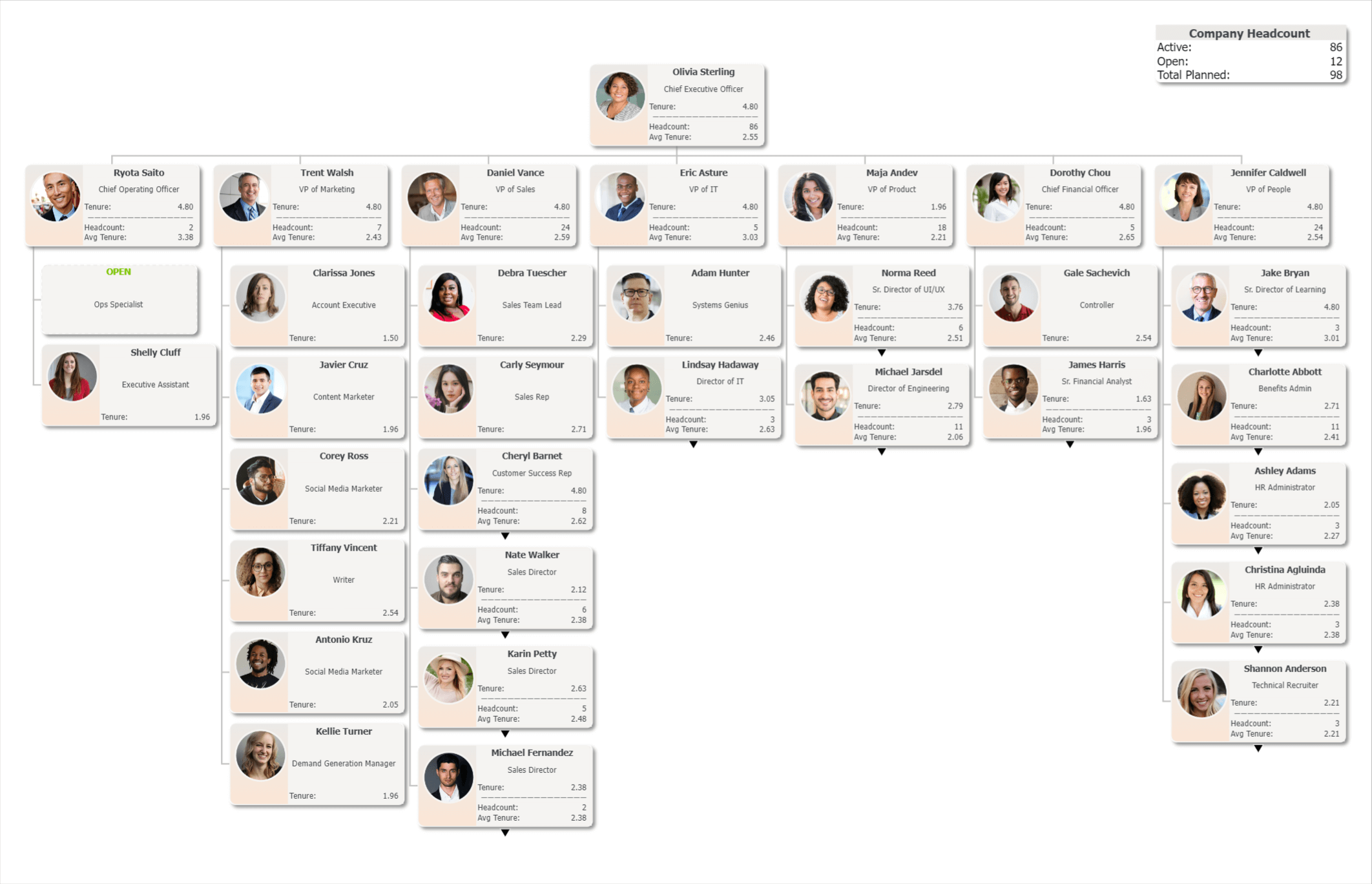May 15, 2024
8:30 AM
By OrgChart Team

A construction company organizational chart is an essential tool to identify inefficiencies, gaps, and opportunities within your human assets.
However, many construction companies have staffing intricacies that can be challenging to understand, leading to confusion among the chain of command and stakeholders.
In this article, we will help you make sense of common construction hierarchies and teach you how to create a well-defined organizational chart in a 4-step process.
Once your org chart is in place, leadership can quickly make informed decisions and execute high-impact strategies that move the business forward.
Before you can build a construction company organizational chart, you need a clear understanding of the roles and responsibilities of your entire team. We’ve defined them below.
Now, let’s examine construction department structures. Understanding your staff framework will help you quickly create a company org chart that is detailed, informative, and actionable.
| Operations and Construction Oversees the lifecycle of construction projects, working on everything from initial planning to final execution. | Finance and Accounting Manages budgets, financial reporting, and ensures controls are in place to sustain the company’s economic health. | Human Resources Recruits qualified staff, manages employee relations, and implements SOPs and company culture initiatives. |
| Purchasing Secures acquisition of materials and services at competitive prices, which is vital for timely, on-budget project completion. | Projects Handles the detailed planning and execution of construction projects, ensuring they meet deadlines and specifications. | Engineering Develops the design and technical specifications of projects, ensuring safety, sustainability, and compliance. |
| Marketing Creates strategies to enhance the company’s market presence, engaging customers and stakeholders through promotional activities. | Information Technology (IT) Supports operations with technological tools and systems, managing data integrity and communication. | Business Development Identifies and develops new opportunities, focusing on strategic partnerships and market expansion. |
| Legal Ensures the company adheres to regulations, managing risks and protecting rights in contractual agreements. | Safety Management Implements safety protocols to ensure a safe working environment and compliance with occupational health standards. | Sustainability and Environment Promotes sustainable company practices to reduce environmental impact and comply with regulations. |
| Technology and Innovation Drives integration of new technologies, enhancing efficiency and enabling innovative approaches. |
Let’s discuss how to craft a visual representation of your staff, highlight key positions, and clarify responsibilities.
Organizational charts can be completely individualized. Below, we’ll discuss some nuances of construction company hierarchy charts based on size and how they each serve the organization.
Larger companies have complex structures and multiple levels of hierarchy. While roles, responsibilities, and the chain of command can be challenging to understand, using an organizational chart tool like Org Chart can be helpful.
Org Chart offers a simple interface for large companies to visualize and clarify departments and seniority. It can be integrated with your existing HR platforms in a single click.
Smaller construction companies enjoy a more streamlined organizational chart. With fewer hierarchical levels, the decision-making process also becomes more straightforward and efficient.
Regardless of size, construction company organizational charts help leadership and stakeholders make calculated decisions about future strategies.
Org chart creation can seem daunting – especially if you have a very large organization. Or, you may have people who wear many hats, their tasks spanning several departments.
No matter the challenge, using an integrated org chart management tool like Org Chart makes the task quick and painless.
This is the hardest step if you have limited automations and resources. Whether manually or using your HR systems, start categorizing departments, people, and job titles. Use keywords and filters to make sense of it all.
Manual, written construction company organizational charts are difficult to maintain and share. Plus, using something like Google Sheets, Microsoft Visio, and Excel requires a ton of rework if you need to make a change.
Having the right tool can make all the difference – saving you time, money, and headaches.
User-friendly organizational chart tools like Org Chart are adaptable, customizable, and informative so leadership can instantly visualize and strategize.
A well-defined organizational chart can help streamline workflows, assign tasks more effectively, and ensure that projects are completed on time and within budget.
Having the best org chart tool will expedite these results. Here is a visual from the Org Chart software.
See how easy it is to modify your org chart? Making a simple change won’t alter the entire chart.
Plus, since it connects with your existing HR systems (ADP, HRIS, and more), it can pull other information like pay rates, targets, and an employee’s time until retirement.
This helps you stay on top of everything.
A construction organizational chart should never sit idle. Share it with your team. Incorporate it into presentations. Use it to inform all major business decisions.
With Org Chart software, you can share your chart across channels in just a few clicks – no matter how complex it becomes.

More specifically, the importance of having an org chart that adapts and grows with your organization.
When you make an organizational chart that is data-driven and easily maintained, you will find:
These benefits help your organization become more efficient, effective, and profitable.
Org charts also help you identify gaps, plan for growth, and strategically restructure without time-consuming, costly mistakes.
If you ask us, investing in organizational chart software is a smart decision.
But don’t just take our word for it. Click here to hear how other customers like you are getting the most out of high-impact org charts.
Create your org chart in minutes. Get started today.